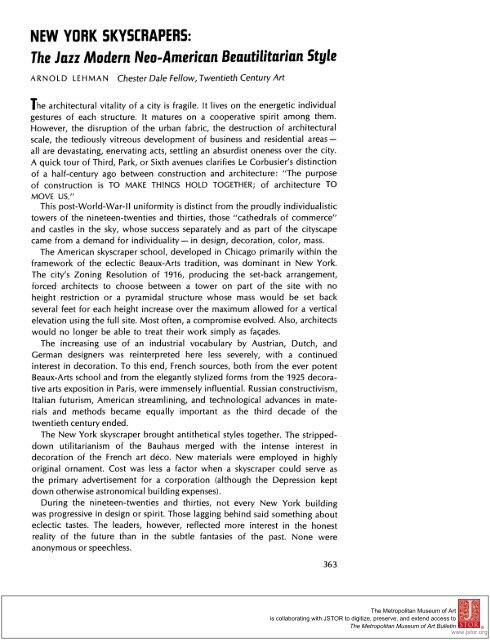The Metropolitan Museum of Art Bulletin, v. 29, no. 8 (April, 1971)
The Metropolitan Museum of Art Bulletin, v. 29, no. 8 (April, 1971)
The Metropolitan Museum of Art Bulletin, v. 29, no. 8 (April, 1971)
- No tags were found...
Create successful ePaper yourself
Turn your PDF publications into a flip-book with our unique Google optimized e-Paper software.
NEW YORK SKYSCRAPERS:<strong>The</strong> Jazz Modern Neo-American Beautilitarian StyleARNOLD LEHMAN Chester Dale Fellow, Twentieth Century <strong>Art</strong><strong>The</strong> architectural vitality <strong>of</strong> a city is fragile. It lives on the energetic individualgestures <strong>of</strong> each structure. It matures on a cooperative spirit among them.However, the disruption <strong>of</strong> the urban fabric, the destruction <strong>of</strong> architecturalscale, the tediously vitreous development <strong>of</strong> business and residential areasallare devastating, enervating acts, settling an absurdist oneness over the city.A quick tour <strong>of</strong> Third, Park, or Sixth avenues clarifies Le Corbusier's distinction<strong>of</strong> a half-century ago between construction and architecture: "<strong>The</strong> purpose<strong>of</strong> construction is TO MAKE THINGS HOLD TOGETHER; <strong>of</strong> architecture TOMOVE US."This post-World-War-li uniformity is distinct from the proudly individualistictowers <strong>of</strong> the nineteen-twenties and thirties, those "cathedrals <strong>of</strong> commerce"and castles in the sky, whose success separately and as part <strong>of</strong> the cityscapecame from a demand for individuality- in design, decoration, color, mass.<strong>The</strong> American skyscraper school, developed in Chicago primarily within theframework <strong>of</strong> the eclectic Beaux-<strong>Art</strong>s tradition, was dominant in New York.<strong>The</strong> city's Zoning Resolution <strong>of</strong> 1916, producing the set-back arrangement,forced architects to choose between a tower on part <strong>of</strong> the site with <strong>no</strong>height restriction or a pyramidal structure whose mass would be set backseveral feet for each height increase over the maximum allowed for a verticalelevation using the full site. Most <strong>of</strong>ten, a compromise evolved. Also, architectswould <strong>no</strong> longer be able to treat their work simply as facades.<strong>The</strong> increasing use <strong>of</strong> an industrial vocabulary by Austrian, Dutch, andGerman designers was reinterpreted here less severely, with a continuedinterest in decoration. To this end, French sources, both from the ever potentBeaux-<strong>Art</strong> school and from the elegantly stylized forms from the 1925 decorativearts exposition in Paris, were immensely influential. Russian constructivism,Italian futurism, American streamlining, and tech<strong>no</strong>logical advances in materialsand methods became equally important as the third decade <strong>of</strong> thetwentieth century ended.<strong>The</strong> New York skyscraper brought antithetical styles together. <strong>The</strong> strippeddownutilitarianism <strong>of</strong> the Bauhaus merged with the intense interest indecoration <strong>of</strong> the French art deco. New materials were employed in highlyoriginal ornament. Cost was less a factor when a skyscraper could serve asthe primary advertisement for a corporation (although the Depression keptdown otherwise astro<strong>no</strong>mical building expenses).During the nineteen-twenties and thirties, <strong>no</strong>t every New York buildingwas progressive in design or spirit. Those lagging behind said something abouteclectic tastes. <strong>The</strong> leaders, however, reflected more interest in the honestreality <strong>of</strong> the future than in the subtle fantasies <strong>of</strong> the past. None werea<strong>no</strong>nymous or speechless.363<strong>The</strong> <strong>Metropolitan</strong> <strong>Museum</strong> <strong>of</strong> <strong>Art</strong>is collaborating with JSTOR to digitize, preserve, and extend access to<strong>The</strong> <strong>Metropolitan</strong> <strong>Museum</strong> <strong>of</strong> <strong>Art</strong> <strong>Bulletin</strong> ®www.jstor.org

















